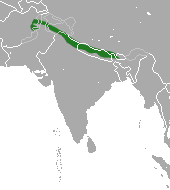Nepalese hanuman langur
| Nepalese hanuman langur | ||||||||||||
|---|---|---|---|---|---|---|---|---|---|---|---|---|

Nepalese hanuman langur ( Semnopithecus schistaceus ) |
||||||||||||
| Systematics | ||||||||||||
|
||||||||||||
| Scientific name | ||||||||||||
| Semnopithecus schistaceus | ||||||||||||
| Hodgson , 1840 |
The Nepalese Hanuman langur ( Semnopithecus schistaceus ) is a primate species from the slender monkey group and is one of the six species into which the subgenus Hanuman langur within the genus of Indian langurs ( Semnopithecus ) is divided in more recent systematics.
features
Compared to other members of its genus, the Nepalese Hanuman Langur is relatively large and dark, but resembles the other species in its slender body with the long tail. In a study in which, however, no distinction was made between Nepalese Hanuman langurs and Tarai Hanuman langurs ( S. hector ), the animals had head-to-trunk lengths of 58 to 76 cm, a tail 75 to 99 cm long and weighed on average 17 kg. The back, the limbs and the tail are gray-brown, the rest of the fur is yellowish-white. The face is dark and hairless, like all Hanuman langurs they are slender, long-tailed animals.
Way of life
These primates are common at the foot of the Himalayas in northern Pakistan , northern India , Nepal , Bhutan and southeastern Tibet , and may also be found in eastern Afghanistan . Their habitat are forests, both subtropical and mountain forests up to 3200 meters above sea level. But they also live close to people, for example in gardens and villages.
Like all Hanuman langurs, they are diurnal and can be found both in the trees and on the ground. They live in groups, some of which are mixed groups of several males and females, and pure groups of males can also be observed. They are herbivores that feed on leaves, fruits, cones, and bark. (For more details, see the way of life of the Hanuman langurs .)
The greatest threat to these primates is the loss of habitat through deforestation, but due to their large distribution area they are not endangered species.
literature
- Thomas Geissmann : Comparative Primatology. Springer-Verlag, Berlin et al. 2003, ISBN 3-540-43645-6 .
- Don E. Wilson, DeeAnn M. Reeder (Eds.): Mammal Species of the World. A taxonomic and geographic Reference. Johns Hopkins University Press, Baltimore MD 2005, ISBN 0-8018-8221-4 .
supporting documents
- ↑ D. Zinner, GH Fickenscher & C. Roos: Family Cercopithecidae (Old World monkeys). Page 735 in Russell A. Mittermeier , Anthony B. Rylands & Don E. Wilson : Handbook of the Mammals of the World: Primates: 3rd ISBN 978-8496553897
Web links
- Semnopithecus schistaceus onthe IUCN Red List of Threatened Species . Retrieved April 19, 2009.
- Sally Walker and Sanjay Molur: Guide to South Asian Primates for Teachers and Students of All Ages (PDF) (1.99 MB)
